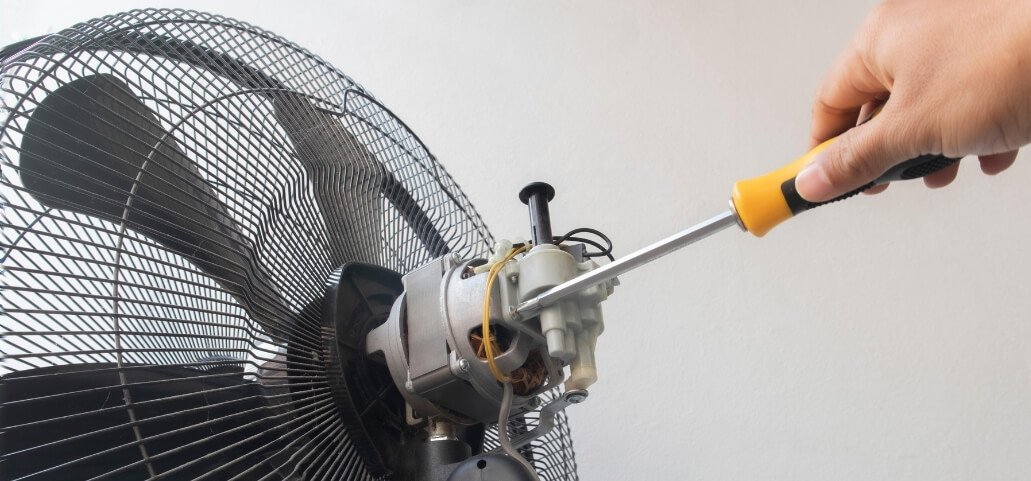Wondering how does an electric fan work? Electric fans, pivotal in maintaining comfort, operate through a fascinating blend of mechanics and electricity. Electric fans are air circulation equipment that may be used in homes, businesses, and factories to provide ventilation or cooling. This guide demystifies their functionality, exploring the inner workings and components that make these devices efficient air circulators. Let’s unravel the science behind how does an electric fan work converts electrical power into the cool, refreshing breeze we rely on.
Components of How Does an Electric Fan Work
Here’s a more detailed explanation of the components of an electric fan:
Fan Blades and Housing
The fundamental elements of how does an electric fan work comprise the fan blades and the housing. The fan blades, typically made from materials like plastic or metal, are engineered with specific aerodynamic designs to efficiently move air. These blades are affixed within a protective housing, ensuring safety and directing the airflow in a particular direction. The shape, angle, and number of blades significantly impact the fan’s performance, determining factors like air circulation volume and noise levels.
Electric Motor
The electric motor, which is responsible for transforming electrical energy into mechanical energy, is located at the center of an electric fan. The blades of the fan are turned in rotation by this motor. In most cases, these motors are of the induction type for AC fans or brushless DC motors for DC fans. The motor’s power and efficiency greatly influence the fan’s performance, including its speed and airflow capacity.
Power Source (AC/DC)
Electric fans are powered by either (AC) or (DC) current. AC-powered fans are common in households and workplaces, typically connected to standard electrical outlets. On the other hand, DC-powered fans are prevalent in portable devices or areas with limited power access. Understanding the power source is crucial as it determines the fan’s compatibility and potential energy efficiency.
Control Mechanisms (Switches, Speed Regulators)
Control mechanisms play a pivotal role in managing the fan’s operation. These mechanisms include switches for turning the fan on or off and regulating its speed. Speed regulators, commonly in the form of knobs or buttons, enable users to adjust the fan’s speed settings according to their preferences. Some advanced fans incorporate smart controls, timers, or remote functionalities, enhancing user convenience and customization.
Understanding the Mechanism of How Does an Electric Fan Work

Understanding the interplay between the electric motor and fan blades elucidates how an electric fan effectively generates airflow and maintains a comfortable environment. Here’s a detailed explanation of the mechanism behind electric fans:
Role of the Electric Motor
The electric motor serves as the powerhouse of how does an electric fan work, performing the critical function of converting electrical energy into mechanical energy. The induction of motion in a motor occurs when a magnetic field, created by the passage of electricity into the motor, interacts with its components. This motion drives the rotation of the motor’s shaft, subsequently setting the fan blades in motion.
Conversion of Electrical Energy to Mechanical Energy
Electric currents and magnetic fields combine to produce this transformation, a process known as electromagnetic induction. The electrical energy supplied to the motor gets converted into mechanical energy, allowing the fan blades to spin and create airflow.
Types of Motors Used in Electric Fans (AC vs. DC)
Electric fans predominantly employ two types of motors: (AC) motors and (DC) motors. AC motors are prevalent in household fans, receiving power from standard electrical outlets. They operate using the alternating flow of electricity, leading to constant speed. DC motors, commonly found in portable fans and some modern household models, offer variable speeds and enhanced energy efficiency. Their adaptability and versatility are enhanced by the fact that they may be powered by batteries or DC sources.
Function of Fan Blades
Fan blades are integral components that determine the efficiency and effectiveness of an electric fan’s operation. Their design and construction significantly impact how air is moved and circulated within a space.
Aerodynamics of Blade Design
The design of fan blades is meticulously crafted to maximize airflow efficiency. Factors such as blade shape, angle, length, and material contribute to the aerodynamics of the blades. Curved or angled blades are designed to push or pull air effectively, minimizing resistance and turbulence while maximizing the volume of air moved per rotation.
Air Circulation and Flow Patterns
Fan blades are structured to create specific airflow patterns, distributing air evenly throughout the space. The airflow is created continuously as the blades spin, drawing in surrounding air and pushing it forward. The movement of air is directed by the blade orientation and housing, ensuring proper circulation and a consistent breeze.
Operation of an Electric Fan

Understanding the operational aspects of an electric fan, including how it starts, controls speed, circulates air, and incorporates safety measures, provides insight into its functionality and usage. Here’s a detailed breakdown of how an electric fan operates:
Switching on the Fan
When you switch on an electric fan, you initiate a sequence that leads to the fan’s operation. The simple action of toggling the switch completes an electrical circuit, allowing the flow of electricity to the fan’s motor. This circuit completion signals the motor to start, initiating the conversion of electrical energy into mechanical energy.
Circuit Completion and Power Flow
When you switch on an electric fan, you initiate a sequence that completes an electrical circuit. Electricity may now move from the power source to the electric motor thanks to this completion. The motor then receives the electrical energy and begins its operation. As the motor starts rotating, it transfers this mechanical energy to the fan blades, setting them in motion.
Speed Control
Electric fans often offer speed control options to adjust the airflow according to personal preference or environmental needs.
Impact of Voltage Variation on Speed
Electric fans often come equipped with speed control settings that enable users to adjust the fan’s rotational speed. The speed control mechanism regulates the voltage supplied to the electric motor. In most cases, increasing the voltage leads to an increase in the motor’s rotational speed, resulting in faster fan blade movement and higher airflow. Conversely, reducing the voltage decreases the speed of the motor and the fan blades, subsequently reducing airflow.
Impact on Air Circulation
The fundamental principle behind an electric fan’s operation is the creation of airflow. Fans achieve this by either pushing or pulling air, generating circulation within a space.
Pushing vs. Pulling Air: How Fans Create Air Movement
Electric fans employ two primary methods to create air movement: pushing and pulling. When the fan blades rotate, they create a pressure difference, either pushing air forward or pulling air backward, depending on the fan’s design. In the case of most household fans, they typically push air forward, creating a breeze that circulates throughout the room. This movement helps in distributing cool air or ventilating a space, enhancing comfort levels.
Overheating and Safety Features
Safety measures on electric fans guard against overheating and guarantee user security. These features often include thermal cutoff switches or temperature sensors that monitor the fan’s internal temperature. If the fan reaches a potentially hazardous temperature level, these safety mechanisms automatically shut off the fan to prevent damage or potential fire hazards. Overheating protection is crucial in maintaining the fan’s longevity and preventing accidents.
Different Types of Electric Fans

Electric fans come in diverse forms and serve various purposes, catering to specific needs and spaces they occupy.
Ceiling Fans
Ceiling fans are fixtures mounted on ceilings, known for their widespread use in homes and commercial spaces. They provide effective air circulation throughout a room by pushing air downwards, creating a breeze that helps maintain a comfortable temperature. These fans are available in various sizes, styles, and blade configurations to complement different interior designs and cooling requirements. Some ceiling fans also include lighting fixtures, offering dual functionality by providing both illumination and air circulation.
Table Fans
Table fans, as the name suggests, are portable fans designed to sit atop tables, desks, or other flat surfaces. Users may arrange them to suit their needs for ventilation thanks to their simplicity and versatility. These fans often feature adjustable tilting heads and multiple speed settings, providing personalized airflow. Table fans are commonly used in offices, bedrooms, or small spaces, offering localized cooling or ventilation.
Tower Fans
Tower fans are slender, vertical fans that efficiently circulate air while occupying minimal space. Their sleek design makes them visually appealing and suitable for modern interiors. Tower fans utilize a combination of oscillation and multiple fan speeds to distribute airflow evenly across a room. They often incorporate additional features such as remote controls, timer settings, and air purification functions, making them a popular choice for those seeking both functionality and aesthetics.
Exhaust Fans
Exhaust fans serve a specific purpose by expelling stale air, odors, moisture, or pollutants from enclosed spaces such as bathrooms, kitchens, or attics. These fans work by drawing out the indoor air and expelling it outside, facilitating better ventilation and improving indoor air quality. Exhaust fans are available in various sizes and installation types, including wall-mounted, ceiling-mounted, or window-mounted options, catering to different space requirements and airflow needs.
Energy Efficiency and Environmental Impact
Electric fans play a significant role in providing comfort and ventilation, but it’s crucial to consider their energy consumption and impact on the environment.
Energy Consumption of Electric Fans
Understanding the energy consumption of electric fans helps gauge their efficiency. A more energy-efficient cooling alternative is to use a fan instead of an air conditioner since fans typically use less power. However, the energy usage varies based on factors such as fan size, motor type, and speed settings. Larger fans or those operating at higher speeds may consume more power. It’s advisable to choose fans with Energy Star ratings or those labeled with energy-efficient features to minimize electricity usage.
Advancements in Energy-Efficient Fan Technology
Energy-efficient fan types are the result of technological developments. Manufacturers continually innovate to enhance motor efficiency, reduce power consumption, and optimize airflow. Certain contemporary fans include characteristics like DC motors, which use less energy than conventional AC motors and are more modern. Additionally, variable speed controls and smart fan technologies allow users to adjust settings to achieve optimal comfort while conserving energy.
Environmental Considerations and Eco-friendly Options
Considering environmental impact is essential when selecting electric fans. Opting for fans made from sustainable materials or those certified as environmentally friendly can contribute to reducing your carbon footprint. In addition, buying long-lasting fans cuts down on the frequency of replacements, which in turn minimizes waste. Some fans also utilize recyclable materials or are designed for easy disassembly, promoting eco-friendly disposal practices.
Additionally, choosing fans with eco-mode settings or programmable timers helps reduce unnecessary energy consumption by automatically adjusting fan operation based on usage patterns or time schedules.
Maintenance and Care Tips
Maintaining your electric fan not only ensures its longevity but also guarantees optimal performance and safety.
Cleaning and Dust Removal
Regular cleaning is essential to keep your electric fan functioning efficiently. Remove the cover or protective grill after disconnecting the fan. Lightly brush away any dust or debris from the fan blades, motor, and housing using a soft brush or vacuum attachment. For stubborn dirt or grease, a damp cloth with mild soap can be used, ensuring the fan is completely dry before reassembly and use. Periodic cleaning prevents dust buildup, which can hinder airflow and strain the motor.
Lubrication of Moving Parts
Your electric fan will run more smoothly and with less friction if the working components are lubricated. For information on lubrication points, consult the manufacturer’s instructions. Some fans may have sealed bearings that don’t require additional lubrication, while others may benefit from a few drops of lubricating oil applied to the motor shaft or other designated areas. Avoid overlubricating since this might lead to problems and attract extra dirt. Follow the recommended schedule for lubrication to maintain optimal performance.
Safety Precautions During Maintenance
Safety is paramount when performing maintenance on electric fans. Before cleaning or doing any maintenance, the fan should always be unplugged. Steer clear of abrasive cleansers and chemicals that can harm the fan’s parts. Take care when handling sharp parts or when disassembling and reassembling the fan to prevent injuries. Additionally, be mindful of electrical hazards and avoid exposing the fan’s motor or electrical components to water or moisture.
Regular maintenance reduces the chance of accidents and extends the life of your electric fan in addition to ensuring that it operates efficiently. By following these maintenance tips and exercising caution during upkeep, you can keep your fan running smoothly and safely for years to come.
Conclusion
In conclusion, understanding how an electric fan works unveils the mesmerizing blend of mechanics and electricity powering your comfort. To get the most out of your fan, you should embrace the science underlying how it works. With a grasp of its components, mechanism, and diverse types, harness the cooling prowess of electric fans to elevate your environment. Stay informed, empower your comfort, and relish the refreshing breeze of knowledge on electric fan functionality!
Frequently Asked Questions
Q1. How does an electric fan work efficiently?
Answer: An electric fan operates efficiently by using well-designed blades and a powerful motor to convert electricity into airflow effectively. Energy-saving features and regular maintenance further enhance its efficiency, optimizing performance while conserving power.
Q2: What makes an electric fan energy-efficient?
Answer: Energy-efficient fans utilize variable speed controls, advanced motor technology, and optimized design to regulate airflow while consuming less power, reducing energy consumption and costs.
Q3: How important is maintenance for electric fans?
Answer: For electric fans to operate smoothly and efficiently, maintenance is essential. Frequent cleaning ensures peak performance and prolongs the life of the fan by preventing dust accumulation.
Q4: What are the key components affecting a fan's efficiency?
Answer: Well-designed blades, a powerful motor, and energy-saving features significantly impact a fan’s efficiency. Together, these components maximize airflow and minimize energy usage.
Q5: How can I maximize the efficiency of my electric fan?
Answer: To maximize efficiency, choose a fan with optimized design features and energy-saving options. Additionally, perform regular maintenance such as cleaning to ensure smooth operation and airflow optimization.

